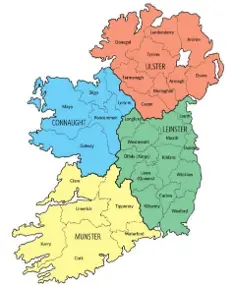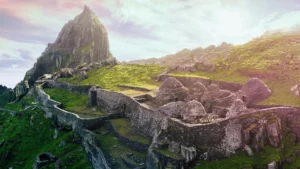Perhaps you didn’t know the tragic story behind “Zombie,” the hit song of The Cranberries, their connection to Ireland, or even why the Irish are known for being so friendly.
Knowing where we come from and how it all began is essential. In this article, we briefly tell you about the history and evolution of Dublin and the island of Ireland: from its Celtic roots to its current political division, so you can better understand the structure and spirit of this city that welcomes you with open arms.

The island of Ireland in the world
Ireland is the third largest island in Europe, located northwest of the continent and surrounded by hundreds of smaller islands and islets.
It is made up of four provinces, which in turn comprise 32 counties:
- Yellow: Munster
- Blue: Connaught
- Red: Ulster
- Green: Leinster

Although the provinces no longer serve a modern political function, they remain an important part of Irish identity.
Today, the island is divided into two countries: Northern Ireland and the Republic of Ireland.
Since 1922, counties Londonderry, Antrim, Down, Armagh, Tyrone, and Fermanagh have belonged to Northern Ireland, while the remaining 26 counties form the Republic of Ireland, an independent country.
Northern Ireland and the Republic of Ireland
The Republic of Ireland occupies five-sixths of the island, while Northern Ireland, part of the United Kingdom, occupies the remaining northeast sixth.
Republic of Ireland
Capital: Dublin
Area: 70,200 km²
Population: 5,060,005
Official languages: English and Irish (Gaelic)
Government: Parliamentary republic
Currency: Euro (€)
Telephone code: +353
Northern Ireland
Capital: Belfast
Area: 14,100 km²
Population: 1,885,000
Languages: English, Irish, and Ulster Scots
Government: Constitutional monarchy
Currency: Pound sterling (£)
Telephone code: +44
A Brief Timeline of Irish History
500 BC → The Celts arrive, a culture that escapes Roman rule.
500 AD → Saint Patrick arrives in Ireland, bringing Christianity to the island.
800 AD → The Vikings found Dublin, which they would dominate for almost three centuries.
12th–16th centuries → The English crown controls Ireland through the Anglo-Normans.
700 years → The struggle for independence from English rule.
1840 → The Great Potato Famine causes more than a million deaths and another million emigrations.
1916 → The Easter Rising breaks out.
1921 → Independence is declared and the island is divided into two countries.
1960 → The IRA armed group emerges, seeking the reunification of Ireland.
1998 → The Good Friday Agreement is signed, marking the end of the armed conflict.
2022 → Walls separating Catholics and Protestants still exist, although the Irish government promises to remove them.
Did you know that…?
The Cranberries’ famous song “Zombie,” written by Dolores O’Riordan, is an anti-war anthem inspired by the tragedy that occurred on March 20, 1993, in Warrington, England.
That day, an IRA (Irish Republican Army) bomb killed Tim Parry (12) and Jonathan Ball (3), and injured dozens more.
The IRA was the main Catholic republican armed organization in Northern Ireland, which for decades used violence to try to separate the territory from the United Kingdom.
O’Riordan explained in a 2017 interview that “Zombie” was “the most aggressive song we wrote,” and that it spoke of the pain and violence that marked Ireland during the 1970s and 1980s:
“In your head, in your head, they are fighting… With their tanks and their bombs…”
The friendly spirit of the Irish
They say Irish friendliness is a reflection of its history. After centuries of English rule, famine, and emigration, the Irish people managed to rise again, building a modern, prosperous country full of cultural pride.
Today, Ireland is a global example of resilience and one of the strongest economies in the European Union.
Furthermore, it has been voted the friendliest country in the world twice since 2009 by Lonely Planet readers.
If you’re interested in learning more about Ireland, we invite you to discover it on the official ELI Schools website.





